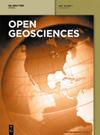Estimation model of wild fractional vegetation cover based on RGB vegetation index and its application
IF 1.3
4区 地球科学
Q3 GEOSCIENCES, MULTIDISCIPLINARY
引用次数: 0
Abstract
An accurate survey of field vegetation information facilitates the evaluation of ecosystems and the improvement of remote sensing models. Extracting fractional vegetation cover (FVC) information using aerial images is one of the important areas of unmanned aerial vehicles. However, for a field with diverse vegetation species and a complex surface environment, FVC estimation still has difficulty guaranteeing accuracy. A segmented FVC calculation method based on a thresholding algorithm is proposed to improve the accuracy and speed of FVC estimation. The FVC estimation models were analyzed by randomly selected sample images using four vegetation indices: excess green, excess green minus excess red index, green leaf index, and red green blue vegetation index (RGBVI). The results showed that the empirical model method performed poorly (validating基于 RGB 植被指数的野生部分植被覆盖率估算模型及其应用
准确调查野外植被信息有助于评估生态系统和改进遥感模型。利用航空图像提取部分植被覆盖(FVC)信息是无人机的重要领域之一。然而,对于植被种类繁多、地表环境复杂的野外,植被覆盖率估算仍难以保证准确性。本文提出了一种基于阈值算法的分段 FVC 计算方法,以提高 FVC 估计的精度和速度。通过随机抽取的样本图像,使用四种植被指数:过量绿色指数、过量绿色减去过量红色指数、绿叶指数和红绿蓝植被指数(RGBVI)对 FVC 估算模型进行了分析。结果表明,经验模型法表现不佳(验证 R 2 = 0.655 至 0.768)。在植被分割中引入了等数据算法和三角阈值算法,并对其准确性进行了分析。结果表明,RGBVI 下的 FVC 估计相关性最高,三角阈值算法和等数据阈值算法在植被识别精度上具有互补性,在此基础上提出了三角阈值算法和等数据阈值算法相结合的 FVC 计算分割方法。经过测试,改进后的 FVC 计算方法准确率高于 90%,植被识别准确率提高到 80%以上。这项研究对在野外调查中使用数码相机具有积极的指导意义。
本文章由计算机程序翻译,如有差异,请以英文原文为准。
求助全文
约1分钟内获得全文
求助全文
来源期刊

Open Geosciences
GEOSCIENCES, MULTIDISCIPLINARY-
CiteScore
3.10
自引率
10.00%
发文量
63
审稿时长
15 weeks
期刊介绍:
Open Geosciences (formerly Central European Journal of Geosciences - CEJG) is an open access, peer-reviewed journal publishing original research results from all fields of Earth Sciences such as: Atmospheric Sciences, Geology, Geophysics, Geography, Oceanography and Hydrology, Glaciology, Speleology, Volcanology, Soil Science, Palaeoecology, Geotourism, Geoinformatics, Geostatistics.
 求助内容:
求助内容: 应助结果提醒方式:
应助结果提醒方式:


